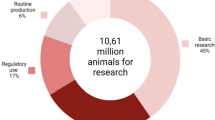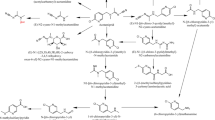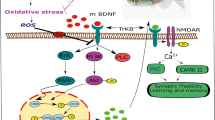Abstract
The objective of this study was to investigate the response of acetylcholinesterase (AChE) activities in Clarias gariepinus in response to Organophosphates (Ops) and carbamate exposure. The AChE activities were determined in plasma, and eye and brain homogenates of unexposed and exposed fish using Ellman’s method and 5,5′-dithiobis-2-nitrobenzoic acid (DTNB) chromophore. The baseline AChE activities in plasma, eyes and brain tissues in unexposed fish were comparable between males and females (P > 0.05). Concentrations of pesticides that inhibited 50% (IC50) of AChE activities in brain homogenates following in vitro exposures were 0.003, 0.03, 0.15, 190, 0.2, 0.003 and 0.002 μM for carbaryl, chlorfenvinphos, diazinon, dimethoate, fenitrothion, pirimiphosmethyl and profenofos, respectively. The in vivo dose–effect relationships were assessed using chlorfenvinphos and carbaryl at different concentrations that ranged from 0.0003 to 0.06 μM and 0.0005 to 0.05 μM, respectively. Acetylcholinesterase activities were comparable in plasma, and eye and brain homogenates from control and carbaryl-exposed fish. Following exposure of fish to chlorfenvinphos at concentrations above 0.03 μM, a significant inhibition of AChE activities in plasma (84%) and eye homogenate (50%) was observed. The AChE activities in brain homogenate were comparable between chlorfenvinphos-exposed fish and controls. Because carbaryl cause reversible inhibition of AChE activities was found to be more potent than chlorfenvinphos that cause irreversible inhibition following in vitro exposure. Contrary, carbaryl was less potent than chlorfenvinphos after in vivo exposure possibly due to more rapid biotransformation of carbaryl than chlorfenvinphos. Findings from this study have demonstrated that inhibition of AChE activity in C. gariepinus is a useful biomarker in assessing aquatic environment contaminated by anticholinesterases.




Similar content being viewed by others
References
Adedeji OB, Adedeji AO, Adeyemo OK, Agbede SA (2008) Acute toxicity of diazinon to the African catfish (Clarias gariepinus). Afr J Biotechnol 7:651–654
Beauvais SL, Jones SB, Parris JT, Brewer SK, Little EE (2001) Cholinergic and behavioural neurotoxicity of carbaryl and cadmium to larval rainbow trout (Oncorhynchus mykiss). Ecotoxicol Environ Saf 49:84–90
Beauvias SL, Cole KJ, Atchison GJ, Coffey M (2002) Factors affecting brain cholinesterase activity in bluegill (Lepomis macrochirus). Water Air Soil Poll 135:249–264
Cerón JJ, Ferrando MD, Sancho E, Gutierrez-Panizo C, Andreu-Moliner E (1996) Effects of diazinon exposure on cholinesterase activity in different tissues of European eel (Anguilla anguilla). Ecotoxicol Environ Saf 35:222–225
Chakraborty PS, Mallik A, Dingal KD, Banerjee S (1989) Effect of methyl parathion on brain and olfactory organ acetylcholinesterase activity of the fish Heteropneustes fissilis. Environ Ecotoxicol 7:310–314
Chambers JE, Boone JS, Carr RL, Chambers HW, Straus DL (2002) Biomarkers as predictors of health and ecological risk assessment. Hum Ecol Risk Assess 8:165–176
Coppage DL, Mathews E (1974) Shorten effect of organophosphate pesticides on cholinesterase of eustarine fishes and pink shrimp. Bull Environ Contam Toxicol 11:483–487
de la Torre FR, Ferrari L, Salibián A (2002) Freshwater pollution biomarker: response of brain acetylcholinesterase activity in two fish species. Comp Biochem Physiol 131C:271–280
Dembélé K, Haubruge E, Gasper C (2000) Concentration effects of selected insecticides on brain acetylcholinesterase in the Common carp (Cyprinus carpio L.). Ecotoxicol Environ Saf 45:49–54
Ecobichon DJ (2001) Toxic effects of pesticides. In: Curtis D, Klaassen CD (eds) Casarett and Doull’s toxicology: the basic science of poisons, 6th edn. Division of McGraw-Hill Companies Inc, New York, pp 763–810
Ellman GL, Courtney KD, Andres VJ, Featherstone RM (1961) A new and rapid colorimetric determination of acetylcholinesterase activity. Biochem Pharmacol 7:88–95
Falfushynska HI, Stolyar OB (2009) Responses of biochemical markers in carp Cyprinus carpio from two field sites in Western Ukraine. Ecotoxicol Environ Saf 72:729–736
Flammarion P, Noury P, Garric J (2002) The measurement of cholinesterase activities as a biomarker in chub (Leuciscus cephalus): the fish length should not be ignored. Environ Pollut 120:325–330
Fulton MH, Key PB (2001) Acetylcholinesterase inhibition in esturine fish and invertebrates as an indicator of organophosphorous insecticide exposure and effects. Environ Toxicol Chem 20:37–45
Galgani F, Bocquene G, Gadiou Y (1992) Evidence of variation of in cholinesterase activity in fish along a pollution gradient in the North Sea. Mar Ecol Prog Ser 91:77–82
Hannam ML, Hagger JA, Jones MB, Galloway TS (2008) Characterization of esterases as potential biomarkers fo pesticide exposure in the lunworm Arenicola marine (Annelida: Polychaeta). Environ Pollut 152:342–350
Lowry OH, Rosebroucgh NJ, Farr AL, Randall R (1951) Protein measurement with folin phenol reagent. J Biol Chem 193:193–265
Marrs TC, Dewhurst I (2000) Toxicology of pesticides. In: Ballantyne B, Marrs TC, Syversen T (eds) General and applied toxicology. Macmillan Reference, Ltd, London, pp 1993–2012
Matton R, Lattam QN (1969) Effect of organophosphate Dylox on rainbow trout larvae. J Fish Res Board Can 26:2193–2200
Mbakaya CFL, Ohayo-Mitoko GJA, Ngowi AVF, Mbabazi R, Simwa JM, Maeda DN, Stephens J, Hakuza H (1994) The status of pesticide usage in East Africa. Afr J Health Sci 1:37–41
Mdegela RH (2006) Evaluation of biomarkers in Clarias gariepinus for biomonitoring of environmental pollution in Tanzania. PhD thesis, Norwegian School of Veterinary Science, Oslo, Norway
Mdegela RH, Braathen M, Correia D, Mosha RD, Skaare JU, Sandvik M (2006a) Influence of 17α-ethynylestradiol on CYP1A, GST and biliary FACs responses in male african Sharptooth Catfish (Clarias gariepinus) exposed to waterborne Benzo[a]Pyrene. Ecotoxicology 15:629–637
Mdegela RH, Myburgh J, Correia D, Braathen M, Ejobi F, Botha C, Sandvik M, Skaare JU (2006b) Evaluation of Gill filament-based EROD assay in African sharptooth catfish (Clarias gariepinus) as a monitoring tool for water-borne PAH-type contaminants. Ecotoxicology 15:51–59
Mora P, Michel X, Narbonne J (1999) Cholinesterase activity as potential biomarker in two bivalves. Environ Toxicol Pharmacol 7:253–260
Ngowi AV, Maeda DN, Partanen TJ, Sanga MP, Mbise G (2001) Acute health effects of organophosphorus pesticides on Tanzanian small-scale coffee growers. J Expo Anal Environ Epidemiol 11:335–339
Payne JF, Mathieu A, Melvin W, Fancey LL (1996) Acetylcholinesterase, an old biomarker with a new future? Field trials and association with two urban Rivers and a paper mill in Newfoundland. Mar Poll Bull 32:225–231
Rao JV (2006) Toxic effects of novel organophosphorous insecticide (RPR-V) on certain biochemical parameters of euryhaline fish, Oreochromis mosambicus. Pestic Biochem Physiol 86:78–84
Rao KRSS, Rao KVR (1989) Combined action of carbaryl and phenthoate on the sensitivity of the acetylcholinesterase system of the fish Channa punctatus (Bloch). Ecotoxicol Environ Saf 17:12–15
Reinecke SA, Reinecke AJ (2007) The impact of organophosphate pesticides in orchards on earthworms in the Western Cape, South Africa. Ecotoxicol Environ Saf 66:244–251
Rickwood CJ, Galloway TS (2004) Acetylcholinesterase inhibition as a biomarker of adverse effect. A study of Mytilus edulis exposed to the priority pollutant chlorfenvinphos. Aquat Toxicol 67:45–56
Sancho E, Ferrando MD, Andreu E (1998) In vivo inhibition of AchE activity in the European eel Anguilla angulla exposed to technical grade Fenitrothion. Comp Biochem Physiol 120C:389–395
Sancho E, Cerón JJ, Ferrando MD (2000) Cholinesterase activity and hematological parameters as biomarkers of sublethal molinate exposure in Anguilla anguilla. Ecotox Environ Saf 46:81–86
Singh RK, Sharma B (2005) Sub-acute toxicity of carbofuran on acetylcholinesterase activity in the freshwater catfish, Clarias batrachus. J Environ Occup Med 22:403–407
Singh RK, Singh RL, Sharma B (2003) Acute toxicity of carbofuran to a freshwater teleost, Clarias batrachus. Bull Environ Contam Toxicol 70:1259–1263
Skelton PH (2000) A complete guide to freshwater fishes of Southern Africa. Southern Book Publishers, Zimbabwe, pp 229–230
Somnuek C, Cheevaporn V, Saengkul C, William F, Beamish H (2007) Variability in acetylcholinesterase upon exposure to chlorpyrifos and carbaryl in hybrid catfish. Sc Asia 33:301–305
Toś-Luty S, Przebirowska D, Latuszyńska J, Tokarska-Rodak M (2001) Histological and ultrastructural studies of rats exposed to carbaryl. Ann Agric Environ Med 8:137–144
United States Public Health Service Commission (USPHS) (1996) Chlorfenvinphos summary http://www.usphs.gov, accessed on 30 October 2009
URT (2009) The United Republic of Tanzania, Ministry of Agriculture and Food Security. Participatory Agricultural Development and Empowerment Project. World Bank/Government of Tanzania resettlement policy framework. http://www.tanzania.go.tz/agriculture.html accessed on 30 October 2009
Walker CH (2001) Organic pollutants: an ecotoxicological perspective. Taylor and Francis, New York
Wildish DJ, Lister NA (1973) Biological effects of fenitrothion in the diet of brook trout. Bull Environ Contam Toxicol 10:333–339
Wright DA, Welbourn P (2002) Organic compounds. In: Campbell PGC, Harrison RM, de Mora SJ (eds) Environmental toxicology, Cambridge environmental chemistry series 11. Cambridge University Press, Cambridge, pp 355–362
Yadav A, Singh RK, Sharma B (1998) Interaction of carbofuran with acetylcholinesterase from the brain of the teleost, Clarias batrachus. Toxicol Environ Chem 65:245–254
Yadav A, Gopesh A, Pandey RS, Devendra K, Rai DK, Sharma B (2009) Acetylcholinesterase: a potential biochemical indicator for biomonitoring of fertilizer industry effluent toxicity in freshwater teleost, Channa striatus. Ecotoxicology 18:325–333
Zinkl JG, Shea PJ, Nakamoto RJ, Callman J (1987) Brain cholinesterase activity of rainbow trout poisoned by carbaryl. Bull Environ Contam Toxicol 38:29–35
Acknowledgements
This study was kindly funded by the Norwegian Universities’ Committee for Development Research and Education (NUFU) PRO 08/2002. We express our sincere thanks for the technical assistance we received from A. Kitime, P. Mkuchu, A. Chambo, H. Mbena and A. Mjema.
Author information
Authors and Affiliations
Corresponding author
Rights and permissions
About this article
Cite this article
Mdegela, R.H., Mosha, R.D., Sandvik, M. et al. Assessment of acetylcholinesterase activity in Clarias gariepinus as a biomarker of organophosphate and carbamate exposure. Ecotoxicology 19, 855–863 (2010). https://doi.org/10.1007/s10646-010-0466-3
Accepted:
Published:
Issue Date:
DOI: https://doi.org/10.1007/s10646-010-0466-3




